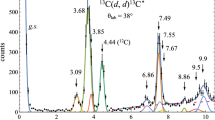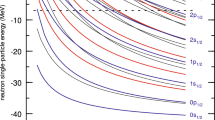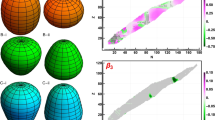Abstract
The region of the nuclear chart with atomic number Z = 80–83 (Hg-Bi) and neutron number N = 118–126, which is the subject of many recent investigations, has revealed the presence of quite long-lived states at high excitation energy and spin. Some noteworthy results include the 8-ms, spin (51/2) isomer at about 8 MeV in 205Bi, and the 60-ns, spin 28 level at 13.67 MeV in 208Pb. The states in 205Bi and 208Pb have the longest half-life and the highest excitation energy of isomers above 7 MeV identified across the nuclear chart yet. The recently discovered isomers are exceptional in terms of half-life, excitation energy or spin, and are built on excitations of the 208Pb core, which is the heaviest doubly-magic nucleus. The properties of these isomers with multi-quasiparticle configurations, involving nucleons in predominantly high-j orbitals below and above the Z = 82 and N = 126 shell gaps, are challenging to reproduce through large-scale shell-model calculations owing to the constraints imposed by the large model space. These metastable states constitute the means to discriminate between and serve to improve the available nuclear effective interactions.






Similar content being viewed by others
Data Availability Statement
Data from some of the work in this review are available from the corresponding author on reasonable request.
References
J.M. Reid, K.G. McNeill, The photo-production of an isomeric state in \(^{207}\)Pb. Phil. Mag. 45, 957 (1954). https://doi.org/10.1080/14786440908520508
D. Eccleshall, M.J.L. Yates, The \(h_{11/2}\) single proton hole state in \(^{207}\)Tl. Phys. Lett. 19, 301 (1965). https://doi.org/10.1016/0031-9163(65)90997-2
G.H. Dulfer et al., Negative parity states in \(^{198}_{80}\)Hg\(_{118}\). Nucl. Phys. A 153, 121 (1970). https://doi.org/10.1016/0375-9474(70)90760-8
H. Ton et al., Lifetimes of high-spin states in doubly even Pt and Hg isotopes. Nucl. Phys. A 153, 129 (1970). https://doi.org/10.1016/0375-9474(70)90761-X
C. Günther et al., High-spin states in even hg nuclei and rotation alignment in \(^{198}\)Hg. Phys. Rev. C 15, 1298 (1977). https://doi.org/10.1103/PhysRevC.15.1298
D.L. Mock et al., Photo-induced reactions at 20 MeV. Phys. Rev. 74, 1536 (1948). https://doi.org/10.1103/PhysRev.74.1536
P. Euthymiou, P. Axel, Photoproduction of a 100-\(\mu \)sec isomer and its tentative assignment to Hg-201. Phys. Rev. 128, 274 (1962). https://doi.org/10.1103/PhysRev.128.274
I. Uray et al., Excitation of \(12^{-}\) isomeric state of \(^{206}\)Tl by fast neutrons. Z. Phys. A 287, 51 (1978). https://doi.org/10.1007/BF01408360
T.W. Conlon, M2 isomerism in the N = 123 isotones. Nucl. Phys. A 212, 531 (1973). https://doi.org/10.1016/0375-9474(73)90821-X
M.G. Slocombe et al., A study of states in \(^{201,203}\)Tl using the (\(d, 3n\gamma \)) reaction: a new \(9/2^{-}\) band. Nucl. Phys. A 275, 166 (1977). https://doi.org/10.1016/0375-9474(77)90282-2
I. Bergstrom, et al. Evidence for a 3.6 Minute Isomeric \(12^{-}\) State of the \(\pi h_{11/2}^{-1} \nu i_{13/2}^{-1}\) configuration in \(^{206}\)Tl and effective two-particle interactions. Z. Phys. A278, 257 (1976). https://doi.org/10.1007/BF01409176
B. Fant et al., Investigation of the high-spin structure of \(^{200,202}\)Pb. Nucl. Phys. A 475, 338 (1987). https://doi.org/10.1016/0375-9474(87)90170-9
A.R. Poletti et al., Structure of high-spin yrast states in \(^{205}\)Pb and \(^{206}\)Pb. Nucl. Phys. A 580, 43 (1994). https://doi.org/10.1016/0375-9474(94)90814-1
R. Broda et al., Inelastic and transfer reactions in \(^{92}\)Mo\(+255\) MeV \(^{60}\)Ni collisions studied by \(\gamma \gamma \) coincidences. Phys. Lett. B 251, 245 (1990). https://doi.org/10.1016/0370-2693(90)90930-5
M. Pfutzner et al., New isotopes and isomers produced by the fragmentation of \(^{238}\)U at 1000 MeV/nucleon. Phys. Lett. 444B, 32 (1998). https://doi.org/10.1016/S0370-2693(98)01332-X
I.Y. Lee, The Gammasphere. Nucl. Phys. A 520, c641 (1990). https://doi.org/10.1016/0375-9474(90)91181-P
R. Janssens, F. Stephens, New physics opportunities at gammasphere. Nucl. Phys. News 6, 9 (1996). https://doi.org/10.1080/10506899609411095
H.J. Kim, W.T. Milner, Short nuclear lifetime measurements via the pulse beam delayed-coincidence technique. Nucl. Instr. and Meth. 95, 429 (1971). https://doi.org/10.1016/0029-554X(71)90541-6
S.K. Tandel et al., Isomers and oblate rotation in Pt isotopes: delineating the limit for collectivity at high spins. Phys. Lett. B 750, 225 (2015). https://doi.org/10.1016/j.physletb.2015.09.019
B. Szpak et al., Isomeric states observed in heavy neutron-rich nuclei populated in the fragmentation of a \(^{208}\)Pb beam. Phys. Rev. C 83, 064–315 (2011). https://doi.org/10.1103/PhysRevC.83.064315
S.G. Wahid et al., Metastable states from multinucleon excitations in \(^{202}\)Tl and \(^{203}\)Pb. Phys. Rev. C 102, 024–329 (2020). https://doi.org/10.1103/PhysRevC.102.024329
V. Bothe et al., Isomers in \(^{203}\)Tl and core excitations built on a five-nucleon-hole structure. Phys. Rev. C 105, 044–327 (2022). https://doi.org/10.1103/PhysRevC.105.044327
T. Kibedi et al., Evaluation of theoretical conversion coefficients using Br Icc. Nucl. Instrum. Methods Phys. Res. A589, 202 (2008). https://doi.org/10.1016/j.nima.2008.02.051
A. Gorgen et al., Spectroscopy of \(^{200}\)Hg after incomplete fusion reaction. Eur. Phys. J A 6, 141 (1999)
S. Suman et al., Nanosecond isomers and the evolution of collectivity in stable, even-\(A\) Hg isotopes. Phys. Rev. C 103, 014–319 (2021). https://doi.org/10.1103/PhysRevC.103.014319
B. Szpak et al., Isomeric states observed in heavy neutron-rich nuclei populated in the fragmentation of a \(^{208}\)Pb beam. Phys. Rev. C 83, 064–315 (2011). https://doi.org/10.1103/PhysRevC.83.064315
J. Wrzesinki et al., High-spin yrast structure of \(^{204}\)Hg from the decay of a four-hole, \(22^{+}\) isomer. Phys. Rev. C 92, 044–327 (2015). https://doi.org/10.1103/PhysRevC.92.044327
S.J. Steer et al., Isomeric states observed in heavy neutron-rich nuclei populated in the fragmentation of a \(^{208}\)Pb beam. Phys. Rev. C 84, 044–313 (2011). https://doi.org/10.1103/PhysRevC.84.044313
B. Fornal et al., Effective charge of the \(\pi h_{11/2}\) orbital and the electric field gradient of Hg from the Yrast structure of \(^{206}\)Hg. Phys. Rev. Lett. 87, 212–501 (2001). https://doi.org/10.1103/PhysRevLett.87.212501
K.H. Maier et al., Measurement of the quadrupole moment of the \({5}^{-}\) level in \(^{206}\rm Hg \). Phys. Rev. C 30, 1702–1705 (1984). https://doi.org/10.1103/PhysRevC.30.1702
P. Roy et al., Isomers from intrinsic excitations in \(^{200}\)Tl and \(^{201,202}\)Pb. Phys. Rev. C 100, 024–320 (2019). https://doi.org/10.1103/PhysRevC.100.024320
S.G. Wahid, et al. Single-particle states and isomers in \(^{202}\)Tl and \(^{203}\)Pb. Proc DAE Int Symp Nucl. Phys. 63-228 (2018)
R. Broda et al., High-spin states and isomers in the one-proton-hole and three-neutron-hole \(^{204}\)Tl isotope. Phys. Rev. C 84, 014–330 (2011). https://doi.org/10.1103/PhysRevC.84.014330
M. Bowry et al., Population of high-spin isomeric states following fragmentation of \({}^{238}\)U. Phys. Rev. C 88, 024–611 (2013). https://doi.org/10.1103/PhysRevC.88.024611
P. Roy, et al. Isomers and intrinsic excitations at high spin in \(^{201}\)Tl. Proceedings of the DAE International Symposium on Nucl. Phys. 63-238 (2018)
J. Wrzesinski et al., The \(\pi h_{11/2}^{-1} \nu i_{13/2}^{-2}\) three-hole isomeric state and octupole core excitation in the \(^{205}\)Tl nucleus. Eur. Phys. J A 20, 57 (2004). https://doi.org/10.1140/epja/i2003-10194-y
R. Broda et al., Doubly magic \(^{208}\)Pb: high-spin states, isomers, and \(E3\) collectivity in the yrast decay. Phys. Rev. C 95, 064–308 (2017). https://doi.org/10.1103/PhysRevC.95.064308
S.G. Wahid et al., Emergence of an island of extreme nuclear isomerism at high excitation near \(^{208}\)Pb. Phys. Lett. B 832, 137–262 (2022). https://doi.org/10.1016/j.physletb.2022.137262
U. Rosengard et al., Yrast spectroscopy and g-factor measurements in \(^{199}\)Pb, \(^{201}\)Pb and \(^{203}\)Pb. Nucl. Phys. A 482, 573 (1988). https://doi.org/10.1016/0375-9474(88)90171-6
M. Rejmund et al., High spin states in \(^{210}\)Pb. Z. Phys. A 359(3), 243–245 (1997). https://doi.org/10.1007/s002180050397
M. Rejmund et al., \(\gamma \) spectroscopy of \(^{209}\)Pb with deep inelastic reactions. Eur. Phys. J. A 1(3), 261–266 (1998). https://doi.org/10.1007/s100500050060
H. Hubel et al., High-spin states in \(^{203}\)Bi populated in the (\(\alpha , 4n\)) reaction. Nucl. Phys. A 294, 177 (1978). https://doi.org/10.1016/0375-9474(78)90402-5
H. Hubel et al., Isomeric transitions in \(^{203}\)Bi and \(^{205}\)Bi. Z. Phys. A 314, 89 (1983). https://doi.org/10.1007/BF01411835
T. Lonnroth et al., High-spin states in \(^{207}\)Bi and the question of three-particle interactions. Phys. Scr. 19, 233 (1979). https://doi.org/10.1088/0031-8949/19/3/003
T. Lonnroth et al., High-spin states in \(^{206}\)Bi populated in the \(^{205}\)Tl(\(\alpha , 3n\)) reaction. Z. Phys. A 287, 307 (1978). https://doi.org/10.1007/BF01481711
J. Wrzesinski et al., Yrast structure of \(^{206}\)Bi: isomeric states and one-proton-particle, three-neutron-hole excitations. Phys. Rev. C 86, 054–322 (2012). https://doi.org/10.1103/PhysRevC.86.054322
M. Rejmund, M. Schramm, K.H. Maier, Derivation of wave functions and matrix elements of the residual interaction in \({}^{208}\rm Pb \) from experimental data. Phys. Rev. C 59, 2520–2536 (1999). https://doi.org/10.1103/PhysRevC.59.2520
M. Rejmund et al., Particle octupole-vibration coupling near \(^{208}\)Pb. Eur. Phys. J. A 8(2), 161–164 (2000). https://doi.org/10.1007/s100500070102
M. Kadi, et al., Decay properties of states populated with the \(^{207}\)Pb(\(n, n^{\prime }\gamma \)) reaction and weak coupling in \(^{207}\)Pb. Phys. Rev. C 61, 034–307 (2000). https://doi.org/10.1103/PhysRevC.61.034307
P. Möller, J. Nix, Nuclear pairing models. Nucl. Phys. A 536(1), 20–60 (1992). https://doi.org/10.1016/0375-9474(92)90244-E
B. A. Brown, et al., Oxbash for Windows PC. MSU-NSCL Report 1289 (2004) (unpublished)
L. Rydström, J. Blomqvist, R. Liotta, C. Pomar, Structure of proton-deficient nuclei near \(^{208}\)Pb. Nucl. Phys. A 512(2), 217–240 (1990). https://doi.org/10.1016/0375-9474(90)93152-V
J. McGrory, T. Kuo, Shell model calculations of two to four identical-“particle’’ systems near \(^{208}\)Pb. Nucl. Phys. A 247(2), 283–316 (1975). https://doi.org/10.1016/0375-9474(75)90637-5
T. Kuo, et al., Naval Res. Lab. Rep. 2258, 1971. (unpublished)
G. Herling, T. Kuo, Two-particle states in \(^{210}\)Pb, \(^{210}\)Bi and \(^{210}\)Po with realistic forces. Nucl. Phys. A 181(1), 113–131 (1972). https://doi.org/10.1016/0375-9474(72)90905-0
A. Kumar, P.C. Srivastava, Shell-model description for the first-forbidden \(\beta \)- decay of \(^{207}\)Hg into the one-proton-hole nucleus \(^{207}\)Tl. Nucl. Phys. A 1014, 122–255 (2021). https://doi.org/10.1016/j.nuclphysa.2021.122255
A. Hosaka, K.I. Kubo, H. Toki, G-matrix effective interaction with the paris potential. Nucl. Phys. A 444(1), 76–92 (1985). https://doi.org/10.1016/0375-9474(85)90292-1
E.K. Warburton, B.A. Brown, Appraisal of the Kuo–Herling shell-model interaction and application to A = 210-212 nuclei. Phys. Rev. C 43, 602–617 (1991). https://doi.org/10.1103/PhysRevC.43.602
Acknowledgements
The author is grateful to Saket Suman for his contribution to different aspects of this work, and for his help in preparing this manuscript. S. G. Wahid, V. Bothe, Poulomi Roy, P.C. Srivastava, M. Hemalatha, P. Chowdhury, F.G. Kondev, R.V.F. Janssens, M.P. Carpenter, D. Seweryniak and T. Lauritsen contributed to a significant part of the results included in this review. The author would like to thank the Shiv Nadar Foundation (SNF). Part of the material was obtained through work supported by the U.S. Department of Energy, Office of Science, Office of Nuclear Physics, under award numbers DE-FG02-94ER40848 (UML), DE-FG02-97ER41041 (UNC) and DE-FG02-97ER41033 (TUNL), and contract number DE-AC02-06CH11357 (ANL). Some of the research described here utilized resources of the ATLAS facility at ANL, which is a DOE Office of Science user facility. The author acknowledges financial support from the Department of Science and Technology, Government of India (Grant No. IR/S2/PF-03/2003-III) for the Indian National Gamma Array (INGA) project, and thanks the INGA collaboration.
Author information
Authors and Affiliations
Corresponding author
Rights and permissions
Springer Nature or its licensor (e.g. a society or other partner) holds exclusive rights to this article under a publishing agreement with the author(s) or other rightsholder(s); author self-archiving of the accepted manuscript version of this article is solely governed by the terms of such publishing agreement and applicable law.
About this article
Cite this article
Tandel, S.K. Multi-neutron-hole and core-excited configurations of isomeric states near the doubly-magic \(^{208}\)Pb. Eur. Phys. J. Spec. Top. (2024). https://doi.org/10.1140/epjs/s11734-024-01131-4
Received:
Accepted:
Published:
DOI: https://doi.org/10.1140/epjs/s11734-024-01131-4




